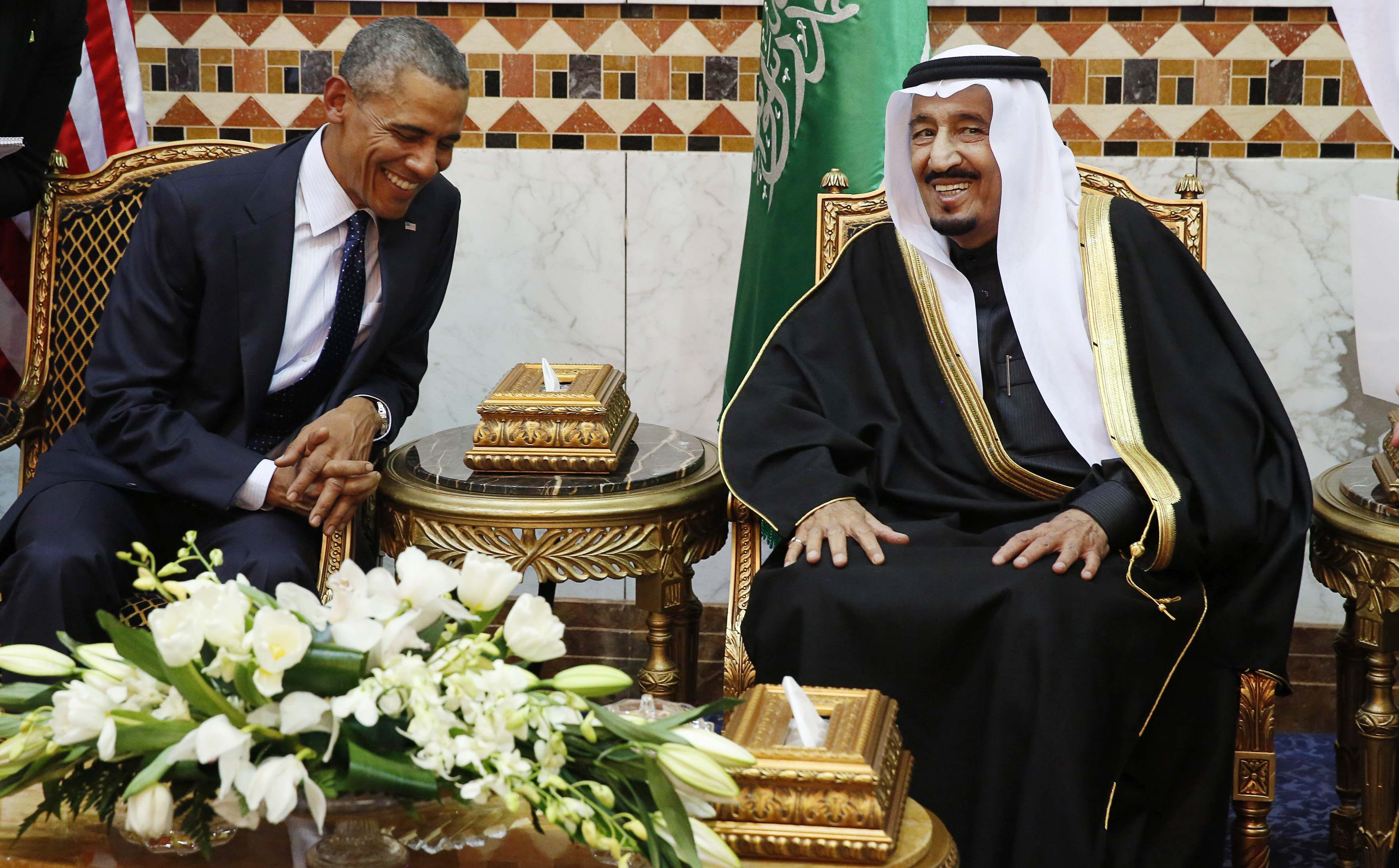Discussions of the Middle East are often synonymous with two topics: the commodity of oil and US involvement in the region. The United States and Saudi Arabia, two ostensible allies, face a conflict of interests as the US continues to engage in nuclear negotiations with Iran and Saudi Arabia deploys air assaults on the Iranian-backed Houthis in Yemen. Due to the US’s continued alliance with Israel and its recent reestablishment of diplomatic ties with Iran, Saudi Arabia has seen a decline in the prominence of its national interests in US policy. Weakened diplomacy is not the only threat to US-Saudi relations: surpluses of oil are destabilizing the commodity market and driving down profits throughout the industry. As two of the highest oil producing states in the market, the US and Saudi Arabia find common ground in their mutual desire for stable and profitable oil prices — achieved through strategic cooperation and agreement on oil policies.
Since its establishment in 1960, a primary goal of the Organization of Petroleum Exporting Countries (OPEC) has been to reach and maintain a stable price in the international trade of oil. On November 27, 2014, head delegates from its 12 member nations met in Vienna to host the 166th meeting of the conference of OPEC. High on the meeting’s agenda was the discussion of oil prices, which had already fallen more than 40% since June.[1] Superficially, the low prices suggest prosperity, as trillions of US dollars are shifted from producers to consumers, inflation rates are continually reduced, and global GDP increases.[2] Politically, the instability of the market creates a power vacuum, leading nations like Saudi Arabia and the United States to seek security and control in the market. The United States, through hydraulic fracturing (fracking), hopes to continue its ascent into the realm of global oil producing powers. Saudi Arabia, the most redoubtable of the OPEC nations, flexes its muscles of wealth and resource in order to exert power over less opportune oil producers, such as Iran.
Saudi-US relations pertaining to oil began in 1933, when the Saudi Arabian government granted concession for drilling in the country to a subsidiary of the Standard Oil Company of California, which would later grow into the Saudi Arabian Oil Company (ARAMCO, after its former name the Arabian-American Oil Company). In 1945, US President Franklin D. Roosevelt promised cooperation with and consideration of the Arab people in regards to the handling of the conflict between Israel and Palestine. While aboard the USS Quincy with Saudi Arabian King Abdul Aziz, FDR assured the leader that “the defense of Saudi Arabia is a vital interest for the defense of the United States.”[3] FDR’s death shortly thereafter complicated the two nations’ relationship. His successor, Truman, made the United States the first country to recognize the nation of Israel in 1948 – an affiliation that would cause tension between the United States and Arab leaders for decades to follow. Two years later, in 1950, King Abdul Aziz pressured ARAMCO into splitting its profits 50/50 with the Saudi state. By the 1980s, the Saudi Arabian government would assume full control of ARAMCO, making it a state-owned enterprise and member of OPEC. However, the United States and Saudi Arabia were able to find a common enemy in the Soviet Union, with Saudi Arabia’s opposition to the Eastern bloc solidified in its conflict with Yemen in the 1960s.
However, conflicting US and Saudi interests in oil and relations with Israel came to a head in 1973 when the Organization of Arab Petroleum Exporting Countries (OAPEC) made the decision to establish an embargo in response to US support of Israel in the Yom Kippur War. The embargo ultimately proved unsuccessful, as it marked the beginning of the decline of OPEC’s power as a solidified bloc and encouraged investors to seek relations with other oil producing nations, such as Norway.[4] As a result of the loss, Saudi Arabia learned that by decreasing its market share and increasing prices, it would ultimately drive consumers towards its competitors — a lesson which echoes in the current choice not to cut production in order to increase prices.
The post-9/11 relationship between the US and Saudi Arabia was strained due to allegations of Saudi ties to al Qaeda by then Secretary of State Hillary Clinton.[5] However, negative US perceptions of Saudi Arabia that came at the fault of Saudi terrorists did not deter shared interests between the two states: security cooperation, new arms sales, and security training.[6] Relations were restored after the 2003 and 2004 al Qaeda attacks in Saudi Arabia led Saudi leaders to vow to join the US in its fight against terrorism.[7]
The falling oil prices of 2014 opened up a new window of opportunity for interaction between the US and Saudi that could act as a foil to developing US policy in the Middle East. The recent cooperation between the United States and Saudi’s Middle Eastern compatriots, namely Iran and Syria, has left Saudi leaders fearful of dependency on US policy, which they found to be insufficiently supportive of Saudi interests in the region.[8] By March 2015, US oil prices dropped as low as $45 a barrel. This followed Saudi Arabia’s refusal to cut production in order to maintain market share. Saudi Arabia’s actions are based on the hope that US oil production will slow, despite the rise in specialized fracking methods.[9] Oilmen, however, are known to have a knack for scraping together funds to turn a profit even in unfavorable economic circumstances.[10] While a number US shale companies have fallen into bankruptcy as a result of high costs of production and low prices, several firms have proven resilient enough to cause US output levels to plateau rather than crash.[11] Nevertheless, continued production by shale companies at their current rate would require extreme practices of efficiency (i.e. a decrease in factors of production such as labor and capital) to balance the high costs of constant drilling that are necessary for fracking.
Oil offers a chance to approach relations with Saudi Arabia under the guise of economics rather than politics. As falling oil prices create an opening for increased Saudi market power, the US seeks to simultaneously appease several of its diverging Middle Eastern allies — but both states have an opportunity for cooperation that would strategically stabilize their politics in the long term. Looking to maintain its regional hegemonic status, the oil-rich Saudi state — which at the outset of falling oil prices had over $900 billion in savings — produces 1/3 of all oil put out by OPEC countries, and can therefore afford to keep production high and prices low. By manipulating oil prices, Saudi Arabia will sit in a hegemonic position for two reasons: 1) it is the most politically stable country in the region, and 2) it will automatically stop Iran from achieving regional hegemony through profits from high oil prices. As OPEC’s power to control prices and market production proves weak, Saudi Arabia proves not only to be a regional hegemon, but global manipulator of perfect competition. Though the nation does not have monopolistic control of the oil market, its high market share and degree of influence, emphasized in November’s OPEC meeting, will enable it to become a stronger actor in the political economics of the region. By taking advantage of ARAMCO’s size, output, and scale of operation (more than 4 million barrels per day at a cost of around $5 per barrel), Saudi Arabia utilizes an economies of scale model that reduces the power of less efficient oil producing nations.[12] By refusing to cut production, and therefore contributing to the saturation of the oil market, Saudi Arabia is also helping to cut off the money that groups like ISIS — which has been selling crude oil in the range of $40-$60 per barrel — get from oil revenue.[13]
Currently, there is no alliance between private oil producers in the United States and ARAMCO. Although such an alliance would be mutually beneficial, neither side has initiated an agreement because low oil prices do not present an imminent threat to the US economy. The most efficient oil policy between the United States and Saudi Arabia would come in the form of a memorandum of understanding (MoU) – a bilateral agreement that would outline (and thereby assure) common interests and intentions between states. The bilateral agreement between the United States and Saudi Arabia would be established independent of legalities and therefore non-binding.
Such an association would present a number of opportunities for both the Unites States and Saudi Arabia: 1) a pragmatic approach for the US redistribution of alliances throughout the Middle East (i.e. less exclusivity towards Israel, more support for Arab powers), 2) an opportunity to discreetly impair Iran’s economy in ways other than the pre-existing sanctions, 3) a reversal of implications set by the Strategic Cooperation Agreement, and other alliance agreements like it, 4) an opportunity for a formal agreement that would take away from suspicions by Iranian president Rouhani regarding secret deals against Iran conspired by the US and Saudi Arabia, 5) in the wake of the decline of OPEC’s influence, the formation of a new bloc of oil producers who control oil prices to make them stable and favorable to the global economy, and 6) credibility gained by the US through an agreement such as this would be especially important in the wake of the CIA Terror Report, as it would exhibit ostensible efforts to effectively negotiate with an Arab state.
In the midst of sensitive nuclear negotiations with Iran, the Obama administration is attempting to resist pressure from Congress to reimpose heavy sanctions on the Islamic Republic lest the negotiations go awry.[14] A public alliance (an MoU) with a professed adversary of Iran (Saudi Arabia) could create contention between the Obama and Rouhani administrations, especially in the wake of Saudi-led air strikes on Iran-supported Houthi rebels in Yemen.[15] Developing relations with Iran and continuing preexisting ones with Saudi Arabia is not hypocritical, but rather a dichotomous approach by the United States to dispersing diplomatic and economic relations throughout the Middle East. As members of the World Trade Organization, the United States and Saudi Arabia may cooperate on the basis of fair trade and global economic interests. While the paths of economics and politics are continuously intersecting, the price of oil as a commodity is so influential to the health of the global economy that it becomes separate from partisan interests in the US.
A cooperation agreement between the Saudi and the US nations would help to stabilize bilateral relations by acting in the name of economic stability and the Most Favored Nation (MFN) principle. Furthermore, the agreement would pose an opportunity to improve US relations with the region. These improvements would be a result of the relative economic stability brought on by a stabilization of oil prices. The image of the United States in the region would also improve, as the backlash from its historically heavy affiliation with Israel would be counterbalanced throughout the region as talks with Iran and economic cooperation with Saudi Arabia go forward, thus potentially earning the US more acceptance in the Arab community.
The last arrangement of this kind in the region was between the United States and Israel in 1981, under the Reagan administration. The two nations agreed to pursue the main objective of deterring Soviet forces in the region through military cooperation. An agreement between the United States and Saudi Arabia should address the regulation of oil production in a way that efficiently maximizes profits for both nations. Like the nations of OPEC, the US and Saudi Arabia would set production quotas that would seek to approach market equilibrium, thus stabilizing the economy around oil while exerting power over one of the global economy’s most influential commodity markets.
The frequently shifting political landscape of the Middle East makes the seriousness and efficacy of diplomatic endeavors difficult to predict. By focusing on commodity market interests, the US is presented with the potential for an economically secure method of policymaking in the Middle East that deters the risk of conflicting alliances.
References:
[1] “Why the Oil Price Is Falling.” The Economist. The Economist Newspaper, 08 Dec. 2014. Web. 11 Dec. 2014.
[2] “Sheikhs v Shale.” The Economist. The Economist Newspaper, 06 Dec. 2014. Web. 10 Dec. 2014.
[3] Al-Monitor. “Obama’s Presidency Brings Uncertainty to Saudi-US Relations – Al-Monitor: the Pulse of the Middle East.” Al-Monitor. http://www.al-monitor.com/pulse/politics/2013/03/obama-us-saudi-ties.html (accessed December 6, 2013).
[4] Ibid.
[5] Walsh, Declan. “WikiLeaks cables portray Saudi Arabia as a cash machine for terrorists.” The Guardian. http://www.theguardian.com/world/2010/dec/05/wikileaks-cables-saudi-terrorist-funding (accessed December 9, 2014).
[6] Bressler, Lindsey. “The Future of Saudi-US Relations.” Northeastern University Political Review. Northeastern University Political Review, 4 Apr. 2014. Web. 5 Dec. 2014.
[7] LeVine, Stephen. “Frenemies forever: how Washington stopped worrying and learned to love Saudi Arabia, again.” Foreign Policy 184 (2011): 31-33.
[8] Reuters. “Saudi Arabia severs diplomatic ties with US over response to conflict in Syria.” Mail Online. http://www.dailymail.co.uk/news/article-2472680/Saudi-Arabia-severs-diplomatic-ties-US-response-conflict-Syria.html (accessed December 7, 2014).
[9] “WTI Oil Drops Below $60 After Saudis Question Need to Cut.” Bloomberg.com. Bloomberg, 11 Dec. 2014. Web. 11 Dec. 2014.
[10] “Many Winners, a Few Bad Losers.” The Economist. The Economist Newspaper, 25 Oct. 2014. Web. 7 Dec. 2014.
[11] Crooks, Ed. “US Shale industry shows remarkable resilience.” Financial Times, last modified March 15, 2015, http://www.ft.com/intl/cms/s/0/372e52bc-c98b-11e4-a2d9-00144feab7de.html#axzz3WutUr8jj
[12] “Why the Oil Price Is Falling.” The Economist. The Economist Newspaper, 08 Dec. 2014. Web. 11 Dec. 2014.
[13] Mosendz, Polly. “How Much Does ISIS Make on Selling Oil?” Newsweek. 10 Nov. 2014. Web. 7 Dec. 2014.
[14] Klapper, Bradley, Matthew Lee, “Re-imposing sanctions on Iran not as easy as it might sound.” The Washington Post. April 10, 2015. http://www.washingtonpost.com/politics/congress/snap-back-not-so-fast-sanctions-a-big-issue-in-nuke-talks/2015/04/09/2fe3ccaa-df19-11e4-b6d7-b9bc8acf16f7_story.html
[15] Kirkpatrick, David, Mark Mazzetti, “Saudi Arabia Leads Air Assault in Yemen,” The New York Times. March 25, 2015. http://www.nytimes.com/2015/03/26/world/middleeast/al-anad-air-base-houthis-yemen.html?_r=0



